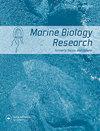Ceriantheomorphe brasiliensis (Cnidaria; Ceriantharia): how does it behave?
IF 1.2
4区 生物学
Q4 ECOLOGY
引用次数: 0
Abstract
ABSTRACT Behaviour research on Cnidaria, particularly Ceriantharia (Cnidaria, Anthozoa), is generally uncommon. Although ceriantharians or tube-dwelling anemones are known to build soft tubes, their tube-building behaviours remain unknown. In this study, we describe for the first time the tube-building behaviour of Ceriantheomorphe brasiliensis and detail its behaviour in natural habitat, including illustrations and videos of live specimens. Our results showed that C. brasiliensis can build more than one tube throughout its life, the tubes are usually ‘L-shaped’, longer than the polyp, and vertically oriented when built in deeper substrates, but horizontally oriented when built in shallower substrates. During tube construction, the polyp does not feed or use its tentacles to catch or select specific sediment particle sizes for tube construction. Given the vertical orientation of the tube, it is possible that the tube-building behaviour of C. brasiliensis differs from that of other species. Although this study only included a single specimen, the behaviours observed were constantly repeated by the animal in every test, from the first trial to the last, suggesting that they can occur on occasion. Furthermore, this research contains useful information that may guide future studies of tube-building behaviour in Ceriantharia which are, currently, non-existent.巴西棘球蚴;Ceriantharia):它是如何表现的?
摘要对刺胞动物,特别是刺胞动物的行为研究通常并不多见。虽然已知白颈海葵或管栖海葵会建造软管,但它们的造管行为尚不清楚。在这项研究中,我们首次描述了巴西白颈猴的造管行为,并详细介绍了其在自然栖息地的行为,包括活体标本的插图和视频。我们的研究结果表明,巴西芽孢杆菌在其一生中可以构建一个以上的管,这些管通常是“l形”的,比珊瑚虫长,在较深的基质中是垂直方向的,在较浅的基质中是水平方向的。在造管过程中,水螅不会进食,也不会用触角捕捉或选择特定的沉积物颗粒大小来造管。考虑到试管的垂直方向,巴西芽孢杆菌的造管行为可能与其他物种不同。虽然这项研究只包括一个样本,但观察到的行为在每次测试中都不断地被动物重复,从第一次试验到最后一次试验,这表明它们偶尔会发生。此外,这项研究包含了有用的信息,可以指导未来对目前不存在的Ceriantharia造管行为的研究。
本文章由计算机程序翻译,如有差异,请以英文原文为准。
求助全文
约1分钟内获得全文
求助全文
来源期刊

Marine Biology Research
生物-海洋与淡水生物学
CiteScore
2.10
自引率
0.00%
发文量
55
审稿时长
6-12 weeks
期刊介绍:
Marine Biology Research (MBRJ) provides a worldwide forum for key information, ideas and discussion on all areas of marine biology and biological oceanography. Founded in 2005 as a merger of two Scandinavian journals, Sarsia and Ophelia, MBRJ is based today at the Institute of Marine Research, Bergen, Norway. The Journal’s scope encompasses basic and applied research from all oceans and marine habitats and on all marine organisms, the main criterium for acceptance being quality.
 求助内容:
求助内容: 应助结果提醒方式:
应助结果提醒方式:


